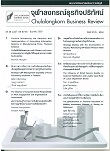ประสิทธิผลของการให้ความรู้ต่อการตัดสินใจเลือกแผนการลงทุนสำหรับการเกษียณอายุ
Main Article Content
Abstract
บทคัดย่อ
งานวิจัยนี้มีวัตถุประสงค์เพื่อศึกษาว่าการให้ความรู้ทางการเงินในรูปแบบการจัดอบรม ที่มีกลุ่มเป้าหมายและเนื้อหาที่เฉพาะเจาะจง จะมีผลต่อการเสริมสร้างความรู้เรื่องทางการเงิน (financial literacy) และปรับเปลี่ยนทัศนคติที่เกี่ยวข้องกับการลงทุนเพื่อการเกษียณอายุ เช่น ความกังวลต่อผลขาดทุนระยะสั้นและทัศคติต่อความเสี่ยง หรือไม่ โดยทำการศึกษาจากตัวอย่างที่เป็นสมาชิกของกองทุนบำเหน็จบำนาญข้าราชการ (กบข.) ผ่านการตอบแบบสอบถามทั้งก่อนและหลังการเข้ารับการอบรมให้ความรู้ในเรื่องการออมเพื่อเกษียณอายุ และแผนการลงทุนแบบสมดุลตามอายุ (life-path investment plan)
การศึกษาพบว่า การให้ความรู้ทางการเงินที่ได้ออกแบบไว้สามารถยกระดับความรู้และปรับเปลี่ยนทัศนคติที่เกี่ยวข้องกับการลงทุนเพื่อการเกษียณอายุได้ โดยผลในการยกระดับความรู้ไม่มีความแตกต่างกันระหว่างตัวอย่างที่มีปัจจัยส่วนบุคคลต่างกัน ในขณะที่ ผลต่อการปรับเปลี่ยนทัศนคติต่อความเสี่ยงมีความแตกต่างกันระหว่างตัวอย่างที่มีภาระทางการเงินต่างกัน นอกจากนี้ยังพบว่า การให้ความรู้มีผลต่อกระบวนการตัดสินใจลงทุนในทุกขั้นตอน กล่าวคือ การรับรู้ของสมาชิกก่อนการเข้ารับการอบรมว่าตนสามารถเลือกแผนการลงทุนได้ สามารถเพิ่มประสิทธิผลของการให้ความรู้ต่อการเห็นด้วยกับหลักการลงทุนแบบสมดุลตามอายุ การที่สมาชิกเห็นด้วยกับหลักการลงทุน ทำให้ประสิทธิผลต่อการยอมรับว่าแผนการลงทุนนี้มีความเหมาะสมกับตนสูงขึ้น การยอมรับดังกล่าวทำให้ประสิทธิผลต่อการตัดสินใจเลือกแผนการลงทุนเองสูงขึ้น และการตัดสินใจเลือกแผนการลงทุนเองทำให้ประสิทธิผลต่อการแนะนำต่อบุคคลอื่นสูงขึ้นเช่นกัน
คำสำคัญ: การให้ความรู้ทางการเงิน; ความรู้เรื่องทางการเงิน; การออมเพื่อการเกษียณอายุ; แผนการลงทุนแบบสมดุลตามอายุ
Abstract
This study measures the effectiveness of financial education to improve financial literacy and attitudes toward investment for retirement of individuals. A tailored-made approach to education on saving for retirement and life-path (or life-cycle) investment plan is used to educate individuals who are members of Thailand’s Government Pension Fund (GPF). The results are analyzed from questionnaires answered by the participants before and after the education sessions.
The results show that an appropriate design of finanicail education could significaintly improve financial literacy as well as the attitudes of the individuals toward investment for retirement. The improvement in financial literacy is not diversed across members, although their characteristics, such as gender, age, and education level, are different. Conversely, the effect of financial education on attitude toward risk depends on whether the individuals have been experiencing financial burden. The study also finds that financial education affects the investors in all steps of their investment decision-making processes. The awareness of investment choices before the education helps increase the effectiveness of education on convincing the participants to accept the principles of life-path investment. This acceptance, in turn, raises the effectiveness of education on the participants to actively make investment choices and to recommend the plan to others.
Keywords: Financial Education; Financial Literacy; Saving for Retirement; Lift Path Investment Plan
Article Details
Opinions and discussions in papers published by the Creative Business and Sustainability Journal (CBSJ) are deemed as personal opinions and the responsibility of the writers. They are not the opinions or responsibility of the Chulalongkorn Business School of Chulalongkorn University.
Papers, content, information etc. appearing in the Journal are deemed to be the copyright property of the Chulalongkorn Business School of Chulalongkorn University. Anybody or any organization that wishes to publish any part of them or use them in any way must obtain written permission from the Chulalongkorn Business School, Chulalongkorn University.


